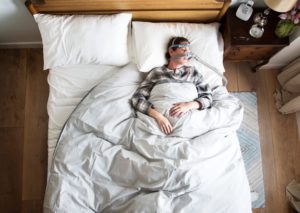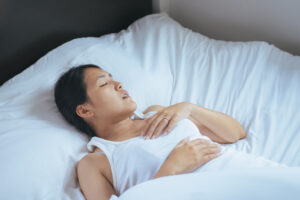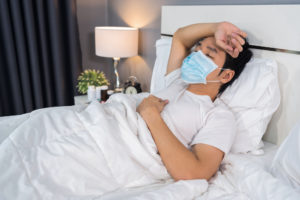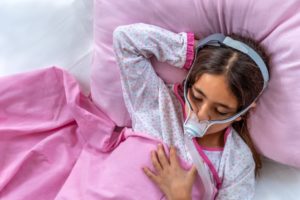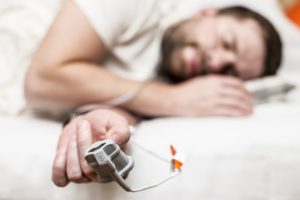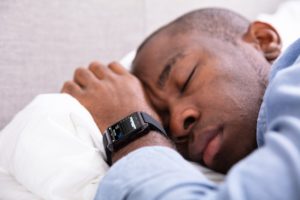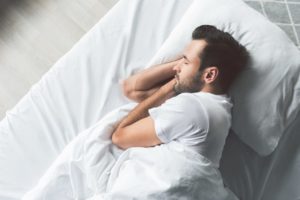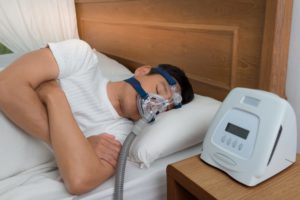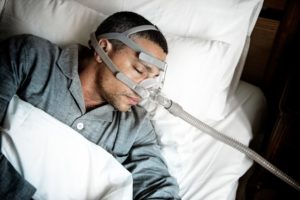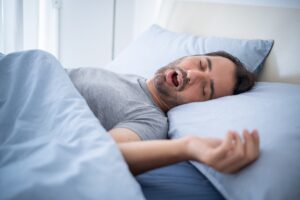When you buy through our links, we may earn a commission. Products or services may be offered by an affiliated entity. Learn more.
Understanding Your Respiratory Rate While Sleeping
- Respiratory rate is your pace of breathing, and it tends to slow while sleeping.
- A low respiratory rate can be caused by sleep apnea, heartburn, or other health conditions.
- A high respiratory rate can be caused by anxiety, infection, or lung conditions.
- See a doctor if you or a partner notices that you have a low or high respiratory rate while sleeping.
A person’s respiratory rate is the number of breaths they take per minute. Like body temperature and heart rate, respiratory rate is a vital sign that can offer a window into a person’s overall health. This is true of both your waking and sleeping respiratory rates, as breathing significantly faster or slower than normal while you sleep can be due to a health condition.
Sleep also has effects on the respiratory rate of everyone, regardless of their health. When we sleep, we naturally begin to breathe differently than we do when we are awake . By learning more about how sleep interacts with the respiratory rate, it’s easier to recognize what is normal for your body and when there might be a problem.
What Is Sleep’s Relationship to Respiratory Rate?
Once we fall asleep, the pace at which we breathe is determined by our metabolic rate . Most people breathe more slowly when they are asleep, and breathing evens out and becomes less variable with each successive stage of sleep. However, research shows that we also breathe faster and more erratically during the rapid eye movement (REM) sleep stage.
Understand Your Sleep Apnea Risk
Answer three questions to take charge of troubled sleep.
What Is a Normal Respiratory Rate During Sleep?
The normal respiratory rate during sleep depends on age .
| Age | Normal Respiratory Rate During Sleep |
|---|---|
| Newborns (up to 12 months) | 30-60 times per minute |
| Toddlers (1 to 2 years) | 24-40 times per minute |
| Young Children (3 to 5 years) | 22-34 times per minute |
| Children (6 to 12 years) | 18-30 times per minute |
| Teens (13 to 17 years) | 13-21 times per minute |
| Adults (over 18 years) | 12-20 times per minute |
| Older Adults (over 60 years) | 12-28 times per minute |
Our respiratory rate at rest changes as we grow older . Children breathe faster than adults, and their average respiratory rate at rest decreases with age .
In addition, infants can also experience something called periodic breathing . An infant’s respiratory rate can vary dramatically during a periodic breathing episode. It may be very low, high, or briefly stop altogether. These episodes are considered normal and not a cause for concern in most children.
How Is Respiratory Rate Measured?
The simplest way of measuring someone’s respiratory rate is by counting how many times they breathe in a minute , usually by watching for the rise and fall of their chest. However, even experts can struggle to perform an accurate count . In medical settings, your respiratory rate might be monitored by a wearable device .
What Does Respiratory Rate Measure?
Although respiratory rate may appear to only measure the number of breaths per minute, it also serves to measure the health of bodily processes that are involved in breathing . Just four breaths over or under the average rate can predict poor medical outcomes in some people. Because of this sensitivity, respiratory rate is an important statistic for health professionals.

What Causes a Low Respiratory Rate During Sleep?
An abnormally low respiratory rate is called bradypnea . Sleep apnea is a breathing disorder that causes people’s breathing to slow and stop for brief periods while they are asleep. There are two major forms of this disorder, obstructive sleep apnea and central sleep apnea.
People may also experience a low respiratory rate while asleep for reasons unrelated to a sleep disorder. Other conditions that can cause bradypnea include:
- Asthma or other lung disorders
- Heartburn
- Pneumonia
- Allergic reaction
- Heart conditions and cardiac arrest
- Drug use or overdose, particularly of a central nervous system depressant
What Causes a High Respiratory Rate During Sleep?
Rapid shallow breathing is called tachypnea , while deep rapid breathing is usually referred to as hyperventilation. However, both terms are sometimes used interchangeably. Neither form of high respiratory rate is a common symptom of any sleep disorder, though tachypnea is sometimes seen in people with sleep apnea being treated with a continuous positive airway pressure (CPAP) machine.
Other causes of an abnormally high respiratory rate include:
- Anxiety and panic attacks
- Asthma
- Chronic obstructive pulmonary disease and other lung conditions
- Lung infections such as pneumonia
- Blood clot in one of the lung’s arteries
- Heart failure
Symptoms of an Abnormal Respiratory Rate While Asleep
An abnormal respiratory rate is considered a symptom itself and may not cause any further symptoms. However, the low respiratory rate associated with sleep apnea can cause people to experience excessive daytime sleepiness, loud snoring, morning headaches, and a decrease in concentration. These symptoms usually respond well to sleep apnea treatments like CPAP therapy.
Most other causes of an abnormal respiratory rate tend to have their own symptoms, which may be acute or chronic.
Should I Talk To My Doctor About My Sleep Respiratory Rate?
Both low and high respiratory rates are often caused by conditions like heartburn or anxiety. However, they might also indicate that something is seriously wrong. Very rapid and shallow breathing is considered a medical emergency when not caused solely by anxiety.
Experts recommend immediate medical attention if someone with a low respiratory rate:
- Goes limp
- Is drowsy or loses consciousness
- Has a seizure
- Turns blue
You should also contact emergency medical services if someone with a high respiratory rate develops:
- Bluish or grayish skin, gums, nails, lips, or eyes
- Pain or a pulling sensation in their chest
- Fever
- Labored or difficult breathing
- An increase in the severity of their symptoms
If you notice that you have an abnormal respiratory rate, consult your doctor. They will be able to determine whether your breathing rate is cause for concern and discover any disorder that may be causing your symptoms.

Still have questions? Ask our community!
Join our Sleep Care Community — a trusted hub of sleep health professionals, product specialists, and people just like you. Whether you need expert sleep advice for your insomnia or you’re searching for the perfect mattress, we’ve got you covered. Get personalized guidance from the experts who know sleep best.
References
15 Sources
-
Gutierrez, G., Williams, J., Alrehaili, G. A., McLean, A., Pirouz, R., Amdur, R., Jain, V., Ahari, J., Bawa, A., & Kimbro, S. (2016). Respiratory rate variability in sleeping adults without obstructive sleep apnea. Physiological Reports, 4(17), e12949.
https://pubmed.ncbi.nlm.nih.gov/27597768/ -
Sowho, M., Amatoury, J., Kirkness, J. P., & Patil, S. P. (2014). Sleep and respiratory physiology in adults. Clinics in Chest Medicine, 35(3), 469–481.
https://pubmed.ncbi.nlm.nih.gov/25156763/ -
Fang, Y., Jiang, Z., & Wang, H. (2018). A novel sleep respiratory rate detection method for obstructive sleep apnea based on characteristic moment waveform. Journal of Healthcare Engineering, 2018, 1902176.
https://pubmed.ncbi.nlm.nih.gov/29599944/ -
Rodríguez-Molinero, A., Narvaiza, L., Ruiz, J., & Gálvez-Barrón, C. (2013). Normal respiratory rate and peripheral blood oxygen saturation in the elderly population. Journal of the American Geriatrics Society, 61(12), 2238–2240.
https://pubmed.ncbi.nlm.nih.gov/24329828/ -
Fleming, S., Thompson, M., Stevens, R., Heneghan, C., Plüddemann, A., Maconochie, I., Tarassenko, L., & Mant, D. (2011). Normal ranges of heart rate and respiratory rate in children from birth to 18 years of age: A systematic review of observational studies. Lancet (London, England), 377(9770), 1011–1018.
https://pubmed.ncbi.nlm.nih.gov/21411136/ -
Kelly, D. H., Stellwagen, L. M., Kaitz, E., & Shannon, D. C. (1985). Apnea and periodic breathing in normal full-term infants during the first twelve months. Pediatric Pulmonology, 1(4), 215–219.
https://pubmed.ncbi.nlm.nih.gov/4069810/ -
Karlen, W., Gan, H., Chiu, M., Dunsmuir, D., Zhou, G., Dumont, G. A., & Ansermino, J. M. (2014). Improving the accuracy and efficiency of respiratory rate measurements in children using mobile devices. PloS One, 9(6), e99266.
https://pubmed.ncbi.nlm.nih.gov/24919062/ -
Perkins, G. D., Stephenson, B., Hulme, J., & Monsieurs, K. G. (2005). Birmingham assessment of breathing study (BABS). Resuscitation, 64(1), 109–113.
https://pubmed.ncbi.nlm.nih.gov/15629563/ -
Massaroni, C., Nicolò, A., Lo Presti, D., Sacchetti, M., Silvestri, S., & Schena, E. (2019). Contact-based methods for measuring respiratory rate. Sensors (Basel, Switzerland), 19(4).
https://pubmed.ncbi.nlm.nih.gov/30795595/ -
Loughlin, P. C., Sebat, F., & Kellett, J. G. (2018). Respiratory rate: The forgotten vital sign-Make it count! Joint Commission Journal on Quality and Patient Safety, 44(8), 494–499.
https://pubmed.ncbi.nlm.nih.gov/30071969/ -
Flenady, T., Dwyer, T., & Applegarth, J. (2017). Accurate respiratory rates count: So should you! Australasian Emergency Nursing Journal: AENJ, 20(1), 45–47.
https://pubmed.ncbi.nlm.nih.gov/28073649/ -
National Library of Medicine (US). (2021, April). Breathing – slowed or stopped. MedlinePlus., Retrieved May 4, 2021, from
https://medlineplus.gov/ency/article/003069.htm -
National Heart, Lung, and Blood Institute. (n.d.). Sleep apnea., Retrieved May 4, 2021, from
https://www.nhlbi.nih.gov/health-topics/sleep-apnea -
National Library of Medicine (US). (2021, April). Rapid shallow breathing. MedlinePlus., Retrieved May 4, 2021, from
https://medlineplus.gov/ency/article/007198.htm -
Gupta, A., Roehrs, T., Moss, K., Jaffery, S., Bazan, L., Spear, L., Darnell, L., & Roth, T. (2018). Tachypnea seen during positive airway pressure titration studies: A case series of four patients. Journal of Clinical Sleep Medicine: Official Publication of the American Academy of Sleep Medicine, 14(10), 1801–1804.
https://pubmed.ncbi.nlm.nih.gov/30353818/










